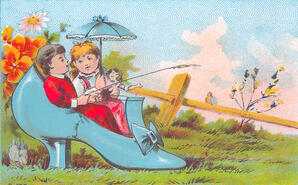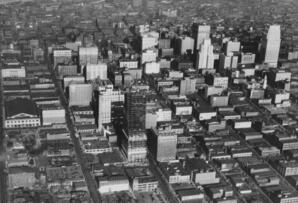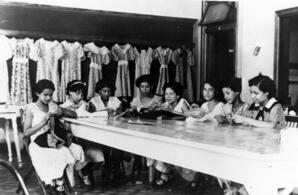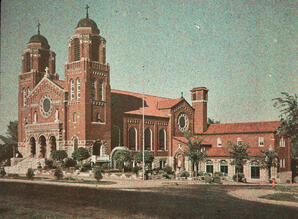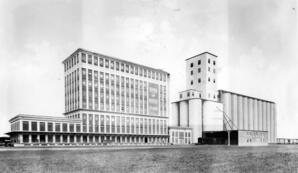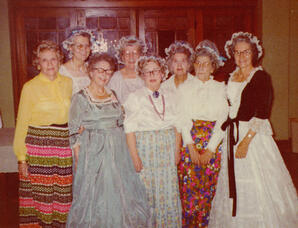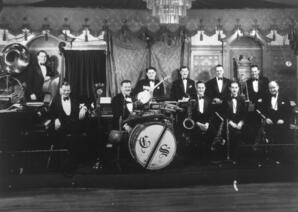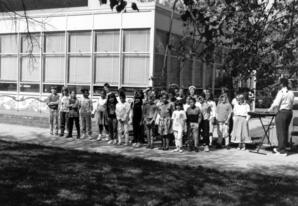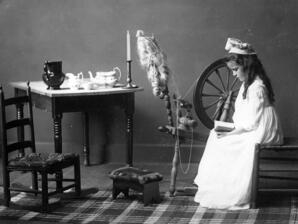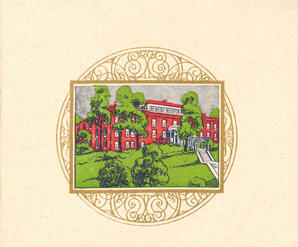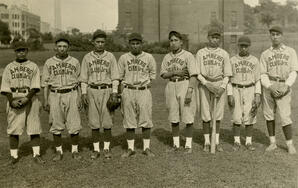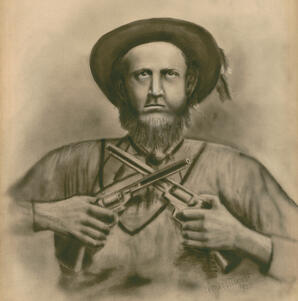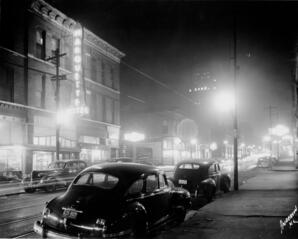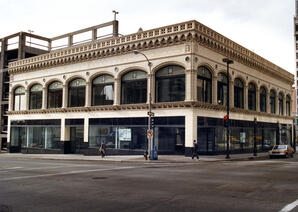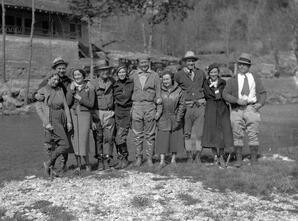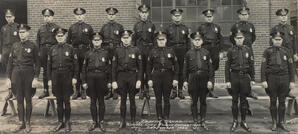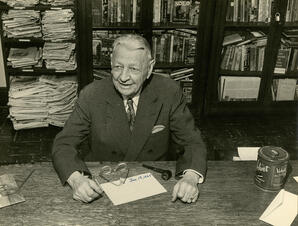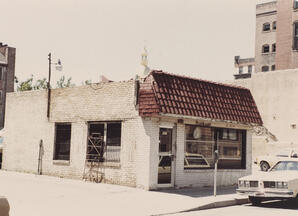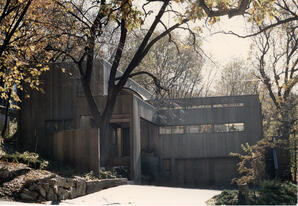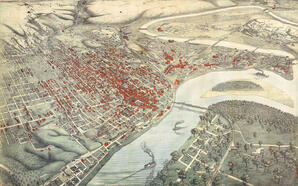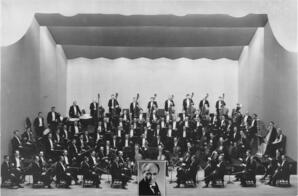The 1951 flood was one of the most devastating natural events in the Kansas City area. The photographer of these 30 images is unknown. Numerous other photographs of the 1951 flood can be found by putting 1951 Flood in the search box or clicking on the "1951 flood" subject heading with one of these photos.
Victorian trade cards, one of the more picturesque collections in the Missouri Valley Room, provide not only a rich resource for researching the history of printing, advertising, medicine, fashions, late nineteenth-century culture, etc., but also Kansas City companies. The cards reached their height of popularity in the 1880s and 1890s.
Curtiss-Wright Flying Service, Photo Division New York City, shot these Kansas City aerial views in the 1920s and '30s. The company's name derived in 1929 from pioneer aircraft engine developer and manufacturer Glenn Curtiss and the famous Wright brothers.
Local photographer Robert G. Askren donated photographs and negatives to the Missouri Valley Special Collections in 2006. Images generally depict Kansas City buildings, parks, streets, important events, local personalities, and aerial views of Kansas City. The bulk of the collection dates from 1950s-1980s.
This eclectic collection consists of images of people and Kansas City places including schools, ice houses, hospitals, street scenes, historical monuments, and more.
During the early 1930s Frank Lauder employed the autochrome process to photograph homes, gardens, and landmarks throughout the Kansas City metropolitan area. These 1400 unique color images provide a truly captivating and one-of-a-kind view of Kansas City's past. Many of the images are close-ups of individual plants and flowers, but also include many exterior views of residences.
In 1926-1928 Henry D. Green created a scrapbook with 78 images that feature business buildings, banks, hotels, and theaters.
Joe Sanders and Carleton Coon co-founded the Coon-Sanders Nighthawks orchestra that gained fame during the 1920s. This digital collection includes many photographs of the orchestra and other performers as well as photographs from Fred Edmiston, author of The Coon-Sanders Nighthawks, and the Harvey Rettberg papers. Rettberg and Clyde Hahn established the Coon-Sanders Nighthawk Fan Club in 1959.
During the 1950s and 1960s, amateur photographer Dorothea Eldridge took slides of Kansas City scenes which include buildings, hospitals, riverfront areas, Municipal Airport, Union Station, the West Bottoms, and more. Of the 108 color slides in the collection, only 24 black and white and two color prints were developed and digitized.
In addition to photographs, this group has images of documents such as letters. Included are the following special collections: James J. Akard (Civil War related papers); Carl Betz; Jim Bridger; Dixon/Jordan Family; Leonard/Guitar Family; Myers Family; Peery Family; Robinson Family; and John Barber White.
This collection contains items relating to the Willows Maternity Home, which operated at 2929 Main Street from 1905 to1969. The institution served as an adoption service and private, temporary home for unwed mothers. It contains materials related to the Willows collected by employee Florence Beal Bolte during the years 1915-1930, including publications, scrapbook pages, and photographs.
The Guadalupe Center began in 1919 when the Agnes Ward Amberg Club for Women established a settlement house primarily for Mexican immigrants. This digital collection of over 550 photographs originally was in three photo albums. Views include the Guadalupe Center Building, events like festivals and fairs, band concerts, athletic teams, camping and outdoor activities, folk festivals, and family activities.
This digital collection consists of 52 charcoal portraits created by artists Anna Lee (Dillenbeck) Stacey and Elmer Stewart. Unfortunately, the provenance for the drawings is unknown. A 1992 library office memo indicates they came to the library many years ago, and that some of the drawings were displayed in the library around the late 1980s. At one time, the portraits were been mounted and perhaps framed, but the mat boards were removed before digitizing. They are now part of the Missouri Valley oversize works (MVO), a collection of various types of art work such as paintings, sculpture, drawings and sketches, large-size photographs, posters, and other miscellaneous items.
The Judge Elmo M. Hargrave Photograph Collection contains images taken circa 1920s-1940s that were used to document accident sites in the city. They provide a unique perspective on the traditional views of streetscapes, businesses, residences, parks, and other locales.
The Historic Kansas City Foundation is a nonprofit organization that advocates for the preservation and rehabilitation of historic buildings, landscapes, and neighborhoods in Kansas City. This collection contains images documenting the preservation efforts of the organization.
The Kansas City Journal-Post came into existence in 1928 when the Kansas City Journal and the Kansas City Post merged. The paper ceased publication in the 1940s, at which time they apparently sold various items. In 1998 Richard Zeldin donated about 400 glass negatives that he said his grandmother had purchased at that sale. Prints were made from the best negatives courtesy of the Friends of the Library. This digital collection of some of the prints showcase sports figures, numerous celebrities, aerial views, aviation, and the Bennett bridge game murder trial.
The Kansas City Police Historical Society Collection consists of scrapbooks, reports, correspondence, ephemera, and photographs relating to the Kansas City Police Department. The Hugh M. Dougherty Scrapbook #1 has been digitized and can be accessed here.
The photographs in this collection come from a portion of The Kansas City Star’s records donated to Missouri Valley Special Collections in 2018. Most are from the research files of former Kansas City Star and Times editor and author Monroe Dodd. Others are from an album of Star newsboys and a miscellaneous photographs folder.
The Landmarks 2020 Addition sub-collection documents the Kansas City built environment from the 1940s to the 1980s.
Kansas City Landmarks Commission donated nearly 1,000 photographs to the Missouri Valley Special Collections. They are divided into four groups, but only three have images in the MVSC Digital Gallery: Health Care; Art Commission Awards; and a group of over 580 Miscellaneous photos primarily from different city departments. Images include architectural award-winning Kansas City locations, area hospitals, Kansas City Police, Fire, Public Works, and Sanitation Departments, the 1951 Flood, the Stockyards, and more.
In 1921, the Liberty Memorial Association held a contest to determine the design of the memorial. Eleven proposals from local and national architectural firms were submitted. The design by New York architect Harold Van Buren Magonigle was selected as the winner. This collection contains 42 black and white photographs of architectural drawings that were submitted by the various firms for the contest.
Digital images include state, county, and city maps as well as road, railroad, river, and other areas like the trails. Due to copyright restrictions, many of the records in this collection do not have an associated image. These may be viewed in the Missouri Valley Room. More maps can be located by searching the Library's online catalog.
Portrait and group shots of musicians, dancers, and actors comprise this digital collection. The following special collections are included: Dory DeAngelo; Charles Johnson; Felice Lyne; Miracle Scrapbook; Helen Seibert Thomes; Youth Symphony; and Kansas City Philharmonic Orchestra Scrapbooks.





